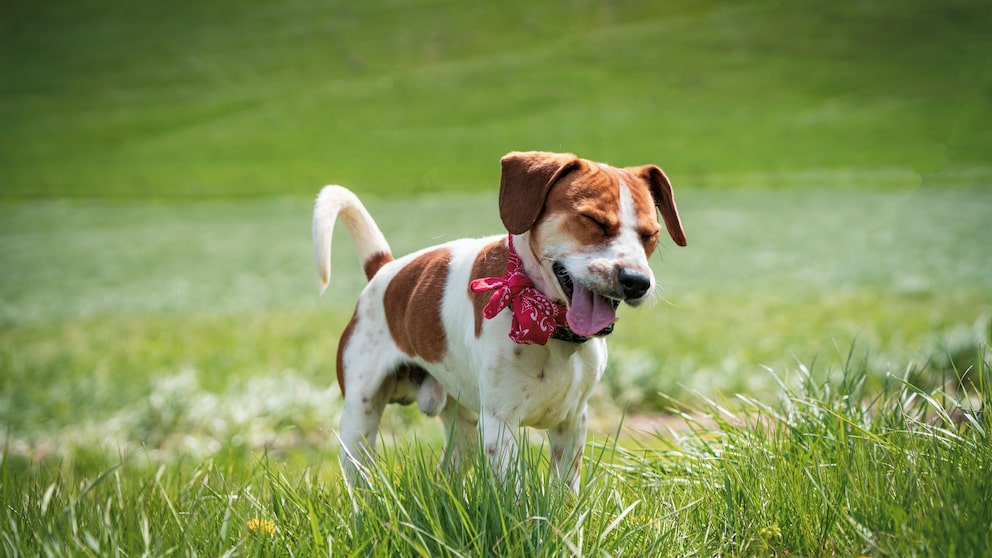March 9, 2025, 9:40 am | Read time: 5 minutes
When people are allergic to tree, grass, and herb pollen, this is known as hay fever. But did you know that our animals also develop such allergies? PETBOOK explains how to tell if your dog or cat is allergic to pollen and how to treat it.
As soon as spring begins, the first pollen starts to fly. Ragweed, mugwort, nettle, birch, beech, alder, ash, hazel, pine, poplar, rye, ribwort, willow, and grasses are particularly popular for allergies. But it’s not just many people whose noses are tingling now; cats and dogs can also develop a pollen allergy. They usually react to the same pollen as us humans. However, our four-legged friends show different symptoms, which is why an allergy often remains undetected for a long time or other triggers are suspected.
PETBOOK explains how you can tell if your dog or cat is suffering from a pollen allergy and how it is diagnosed and treated.
Overview
What Symptoms Can a Cat or Dog Get with a Pollen Allergy?
Many people believe that cats or dogs would sneeze if they suffer from a pollen allergy. However, reactions such as sneezing or a runny nose rarely occur in dogs. What is more common in dogs with hay fever, however, are problems that occur in the respiratory tract, as the Oberhaching Veterinary Clinic explains on its blog. This is because the pollen is not only absorbed through the skin but is also inhaled and causes swelling of the mucous membranes in the airways. The result is wheezing and, in extreme cases, serious respiratory distress.1
If a dog or cat has an allergic reaction to pollen or grass, the body releases histamines. These lead to specific symptoms, which can be different in dogs and cats.
Symptoms of Allergic Reactions to Pollen in Dogs
- Breathing problems
- Lack of appetite
- Watery eyes
- Swelling and redness
- Sneezing
- Inflamed areas on the skin
- Itching
- Frequent licking and rubbing of affected areas
- Hair loss 2
Symptoms of Allergic Reactions to Pollen in Cats
- Breathing problems (strong inhalation and exhalation with breathing noises)
- Asthma with shortness of breath (cat huddles together)
- Itching
- Skin inflammation with crust formation
- Compulsive grooming and scratching
- Hair loss or bald patches, especially on the belly and front and hind legs
3
Note: In cats, signs of watery eyes, sneezing, and a runny nose are usually an indication of a cold and not a pollen allergy.
Diagnosis of Pollen Allergy in Cats and Dogs
As the symptoms of a pollen allergy are quite unspecific, the vet must carry out certain blood and skin tests to rule out other causes. This involves a series of tests, which is very time-consuming.
The following must be ruled out:
- Ectoparasitic infestation (fleas, mites, ticks, etc.)
- Endoparasitic infestation (worms and protozoa)
- Cytological examination of the affected skin areas
- Food allergy
If these tests are negative, the vet will test the animal for an environmental or pollen allergy. With the help of special allergy tests, it is even possible to determine the plants and grasses to whose pollen the immune system reacts with the symptoms described. This is done either with an intradermal test, in which the suspected allergens (various pollens) are injected under the skin, or with a so-called serological allergy test, in which blood is taken from the dog.4
Can I Test My Cat and Dog for Pollen Allergy Myself?
There are blood tests on the market that promise to be able to determine all possible allergens — including pollen. All it takes is hair and saliva from the affected animal, which owners then send in. Unfortunately, these tests are not very reliable, as several studies showed years ago.
How to Help a Cat or Dog Suffering from a Pollen Allergy
If our four-legged friends are allergic to pollen, there are various ways to alleviate the symptoms.
The long walk with the dog should take place in the city in the morning hours between 6 and 8 p.m. If the cat is an outdoor cat, it should do its rounds at this time. The situation is different in the countryside. Here, it is better to take the dog outside between 7 p.m. and midnight, and the cat can now sneak around the houses. After a rain shower, the concentration of pollen decreases — the perfect time to go for a walk.
Doors and windows should be kept closed during periods of heavy pollen counts. If the animals come into the house from outside, you should not only wash their paws but also rub the whole animal with a damp cloth. Eyes, ears, and mouth should also be cleaned.
To keep the pollen load in the house or apartment as low as possible, the floors should be mopped and vacuumed regularly. Also, wipe down cat and dog baskets and wash textiles such as cushions and blankets.

Causes and treatment Does your dog’s bottom slide across the floor? This is what’s behind it

Nerve disease? What is known about incurable rolling skin syndrome in cats

Triggers of diarrhea Giardia in dogs — symptoms, causes, and treatment
Treatment of a Pollen Allergy at the Vet
If the allergy has been confirmed by the vet, the following medication can be used to treat the allergy:
- Antihistamines (cetirizine)
- Mild cortisone preparations
- Possibly painkillers or homeopathic globules
Hyposensitization, as in humans, is also possible. In this case, the animal is given the allergy-causing substance in steadily increasing doses. The aim is for the body to become accustomed to the allergen over time. The injections can be administered by the owner.

